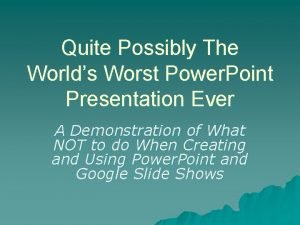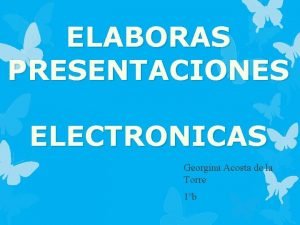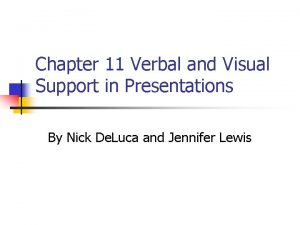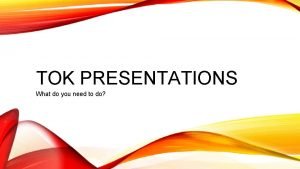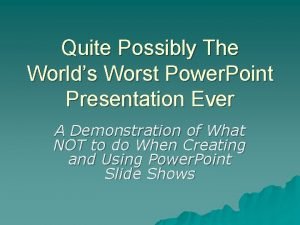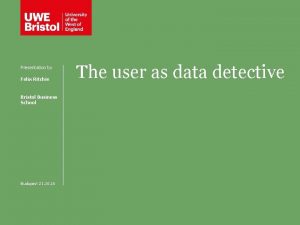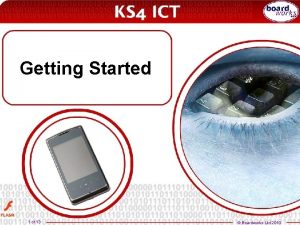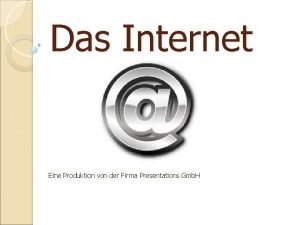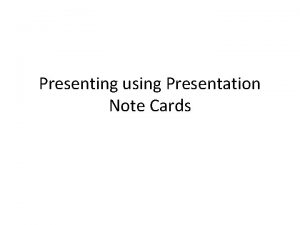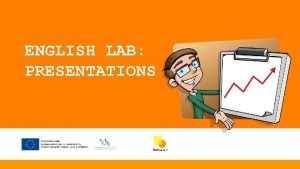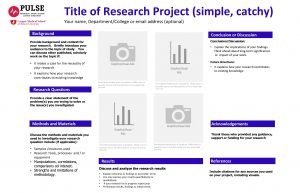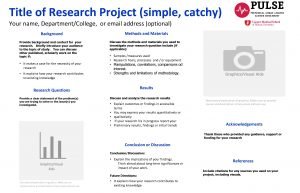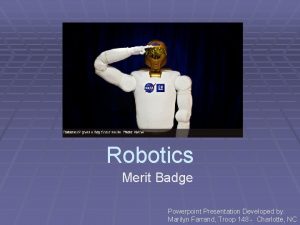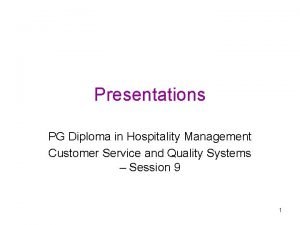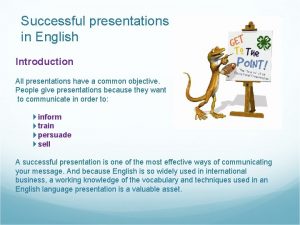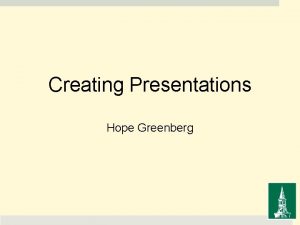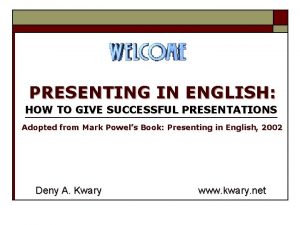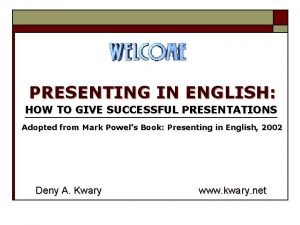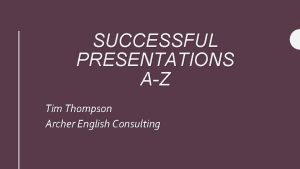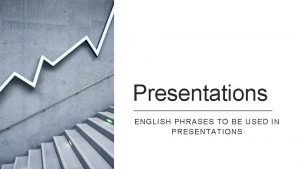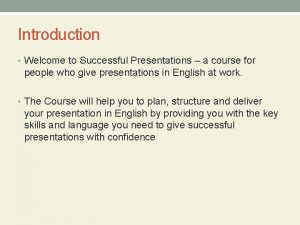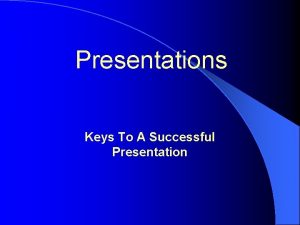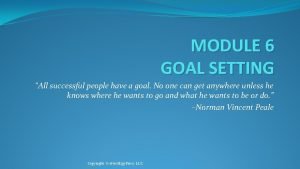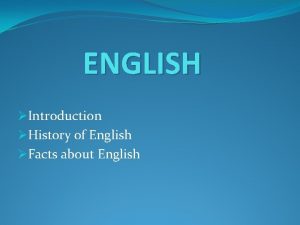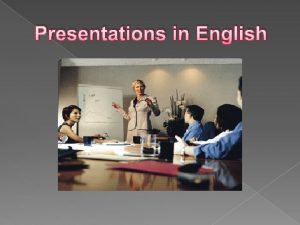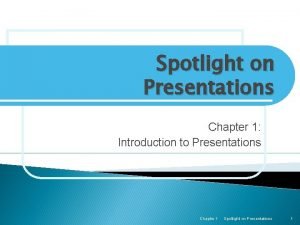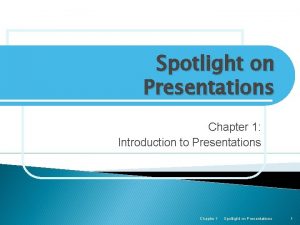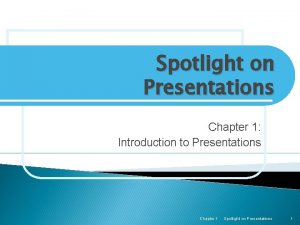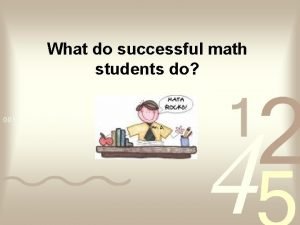Successful presentations in English Introduction All presentations have





























- Slides: 29

Successful presentations in English Introduction All presentations have a common objective. People give presentations because they want to communicate in order to: inform train persuade sell A successful presentation is one of the most effective ways of communicating your message. And because English is so widely used in international business, a working knowledge of the vocabulary and techniques used in an English language presentation is a valuable asset.

Preparation Can you name the 3 most important things when giving any presentation? Number 1 is. . . Preparation Number 2 is. . . Preparation! Number 3 is. . . Preparation!! Preparation is everything! With good preparation and planning you will be totally confident and less nervous. And your audience will feel your confidence. Your audience, too, will be confident. They will be confident in you. And this will give you control. Control of your audience and of your presentation. With control, you will be 'in charge' and your audience will listen positively to your message.

Objective Before you start to prepare a presentation, you should ask yourself: "Why am I making this presentation? " Do you need to inform, to persuade, to train or to sell? Your objective should be clear in your mind. If it is not clear in your mind, it cannot possibly be clear to your audience. Content "What should I say? " Now you must decide exactly what you want to say. First, you should brainstorm your ideas. You will no doubt discover many ideas that you want to include in your presentation. But you must be selective. You should include only information that is relevant to your audience and your objective. You should exclude all other ideas. You will prepare your visual aids. But remember, in general, less is better than more (a little is better than a lot). You can always give additional information during the questions after the presentation.

Structure A well organised presentation with a clear structure is easier for the audience to follow. It is therefore more effective. You should organise the points you wish to make in a logical order. Most presentations are organised in three parts, followed by questions: Short introduction (Beginning ) welcome your audience introduce your subject explain the structure of your presentation explain rules for questions Body of presentation (Middle ) present the subject itself Short conclusion (End ) summarise your presentation thank your audience invite questions Questions and Answers

Notes When you give your presentation, you should be - or appear to be - as spontaneous as possible. You should not read your presentation! You should be so familiar with your subject and with the information that you want to deliver that you do not need to read a text. Reading a text is boring ! Reading a text will make your audience go to sleep! So if you don't have a text to read, how can you remember to say everything you need to say? With notes. You can create your own system of notes. Some people make notes on small, A 6 cards. Some people write down just the title of each section of their talk. Some people write down keywords to remind them. The notes will give you confidence, but because you will have prepared your presentation fully, you may not even need them!

Rehearsal is a vital part of preparation. You should leave time to practise your presentation two or three times. This will have the following benefits: you will become more familiar with what you want to say you will identify weaknesses in your presentation you will be able to practise difficult pronunciations (and do not hesitate to check on www. howjsay. com) you will be able to check the time that your presentation takes and make any necessary modifications So prepare, prepare! Rehearse your presentation several times and time it. Is it the right length? Are you completely familiar with all your illustrations? Are they in the right order? Are you confident about the equipment? When you have answered all these questions, you will be a confident, enthusiastic presenter ready to communicate the subject of your presentation to an eager audience.

Nerves Most speakers are a little nervous at the beginning of a presentation. So it is normal if you are nervous. The answer is to pay special attention to the beginning of your presentation. First impressions count. This is the time when you establish a rapport with your audience. During this time, try to speak slowly and calmly. You should perhaps learn your introduction by heart. After a few moments, you will relax and gain confidence. Audience Rapport You need to build a warm and friendly relationship with your audience. Enthusiasm is contagious. If you are enthusiastic your audience will be enthusiastic too. And be careful to establish eye contact with each member of your audience. Each person should feel that you are speaking directly to him or her. This means that you must look at each person in turn - in as natural a way as possible. This will also give you the opportunity to detect signs of boredom, disinterest or even disagreement, allowing you to modify your presentation as appropriate. Your objective is to communicate!

Body Language What you do not say is at least as important as what you do say. Your body is speaking to your audience even before you open your mouth. Your clothes, your walk, your glasses, your haircut, your expression - it is from these that your audience forms its first impression as you enter the room. Generally speaking, it is better to stand rather than sit when making a presentation. Be aware of and avoid any repetitive and irritating gestures. Be aware, too, that the movement of your body is one of your methods of control. When you move to or from the whiteboard, for example, you can move fast or slowly, raising or reducing the dynamism within the audience.

Voice quality It is, of course, important that your audience be able to hear you clearly throughout your presentation. In general, you should try to vary your voice. Your voice will then be more interesting for your audience. You can vary your voice in at least three ways: speed: you can speak at normal speed, you can speak faster, you can speak more slowly - and you can stop completely! You can pause. This is a very good technique for gaining your audience's attention. intonation: you can change the pitch of your voice. You can speak in a high tone. You can speak in a low tone. volume: you can speak at normal volume, you can speak loudly and you can speak quietly. Lowering your voice and speaking quietly can again attract your audience's interest. The important point is not to speak in the same, flat, monotonous voice throughout your presentation - this is the voice that hypnotists use to put their patients' into trance!

Visual aids Of all the information that enters our brains, the vast majority of it enters through the eyes. 80% of what your audience learn during your presentation is learned visually (what they see) and only 20% is learned aurally (what they hear). The significance of this is obvious: visual aids are an extremely effective means of communication non-native English speakers need not worry so much about spoken English - they can rely more heavily on visual aids But it is equally important not to overload your audience's brains. Keep the information on each visual aid to a minimum - and give your audience time to look at and absorb this information. Remember, your audience have never seen these visual aids before. They need time to study and to understand them. Without understanding there is no communication.

Apart from photographs and drawings, some of the most useful visual aids are charts and graphs, like the 3 -dimensional ones shown here: Piecharts are circular in shape (like a pie). Barcharts can be vertical (as here) or horizontal. Graphs can rise and fall.

Audience Reaction Remain calm and polite if you receive difficult or even hostile questions during your presentation. If you receive particularly awkward questions, you might suggest that the questioners ask their questions after your presentation. Simplicity and Clarity If you want your audience to understand your message, your language must be simple and clear. Use short words and short sentences. Do not use jargon, unless you are certain that your audience understands it. In general, talk about concrete facts rather than abstract ideas.

Signposting When you drive on the roads, you know where you are on those roads. Each road has a name or number. Each town has a name. And each house has a number. In other words, it is easy to navigate the roads. You cannot get lost. But when you give a presentation, how can your audience know where they are? How can they know the structure of your presentation? They know because you tell them. Because you put up signposts for them, at the beginning and all along the route. This technique is called 'signposting' (or 'signalling'). During your introduction, you should tell your audience what the structure of your presentation will be. You might say something like this: "I'll start by describing the current position in Europe. Then I'll move on to some of the achievements we've made in Asia. After that I'll consider the opportunities we see for further expansion in Africa. Lastly, I'll quickly recap before concluding with some recommendations. "

A member of the audience can now visualize your presentation like this: Introduction Welcome Explanation of structure (now) Europe Body Asia Africa Conclusion Summing up Recommendations

He will keep this image in his head during the presentation. He may even write it down. And throughout your presentation, you will put up signposts telling him which point you have reached and where you are going now. When you finish Europe and want to start Asia, you might say: "That's all I have to say about Europe. Let's turn now to Asia. « When you have finished Africa and want to sum up, you might say: "Well, we've looked at the three continents Europe, Asia and Africa. I'd like to sum up now. « And when you finish summing up and want to give your recommendations, you might say: "What does all this mean for us? Well, firstly I recommend. . . "

Signposting Function Language Introducing the subject • I'd like to start by. . . • Let's begin by. . . • First of all, I'll. . . • Starting with. . . • I'll begin by. . . Finishing one subject. . . • Well, I've told you about. . . • That's all I have to say about. . . • We've looked at. . . • So much for. . .

Signposting Function Language . . . and starting another • Now we'll move on to. . . • Let me turn now to. . . • Next. . . • Turning to. . . • I'd like now to discuss. . . • Let's look now at. . . Analysing a point and giving recommendations • Where does that lead us? • Let's consider this in more detail. . . • What does this mean for ABC? • Translated into real terms. . .

Signposting Function Language Giving an example • For example, . . . • A good example of this is. . . • As an illustration, . . . • To give you an example, . . . • To illustrate this point. . . Dealing with questions • We'll be examining this point in more detail later on. . . • I'd like to deal with this question later, if I may. . . • I'll come back to this question later in my talk. . . • Perhaps you'd like to raise this point at the end. . . • I won't comment on this now. . .

Signposting Function Language Summarising and concluding • In conclusion, . . . • Right, let's sum up, shall we? • I'd like now to recap. . . • Let's summarise briefly what we've looked at. . . • Finally, let me remind you of some of the issues we've covered. . . • If I can just sum up the main points. . . Ordering • Firstly. . . secondly. . . thirdly. . . lastly. . . • First of all. . . then. . . next. . . after that. . . finally. . . • To start with. . . later. . . to finish up. . .

Introduction The introduction is a very important - perhaps the most important - part of your presentation. This is the first impression that your audience have of you. You should concentrate on getting your introduction right. You should use the introduction to: welcome your audience introduce your subject outline the structure of your presentation give instructions about questions

The following table shows examples of language for each of these functions. Function Possible language 1 Welcoming your audience • Good morning, ladies and gentlemen • Good morning, gentlemen • Good afternoon, ladies and gentleman • Good afternoon, everybody 2 Introducing your subject • I am going to talk today about. . . • The purpose of my presentation is to introduce our new range of. . .

Function Possible language 3 Outlining your structure 1. To start with I'll describe the progress made this year. Then I'll mention some of the problems we've encountered and how we overcame them. After that I'll consider the possibilities for further growth next year. Finally, I'll summarize my presentation (before concluding with some recommendations). 4 Giving questions instructions about • Do feel free to interrupt me if you have any questions. • I'll try to answer all of your questions after the presentation. • I plan to keep some time for questions after the presentation.

Body The body is the 'real' presentation. Remember these key points while delivering the body of your presentation: do not hurry be enthusiastic give time on visuals maintain eye contact modulate your voice look friendly keep to your structure use your notes signpost throughout remain polite when dealing with difficult questions

Conclusion Use the conclusion to: 1. Sum up 2. (Give recommendations if appropriate) 3. Thank your audience 4. Invite questions

Function Possible language 1 Summing up • To conclude, . . . • In conclusion, . . . • Now, to sum up. . . • So let me summarise/recap what I've said. • Finally, may I remind you of some of the main points we've considered. 2 Giving recommendations • In conclusion, my recommendations are. . . • I therefore suggest/propose/recommend the following strategy.

Function Possible language 3 Thanking your audience • Many thanks for your attention. • May I thank you all for being such an attentive audience. 4 Inviting questions • Now I'll try to answer any questions you may have. • Can I answer any questions? • Are there any questions? • Do you have any questions? • Are there any final questions?

Questions are a good opportunity for you to interact with your audience. It may be helpful for you to try to predict what questions will be asked so that you can prepare your response in advance. You may wish to accept questions at any time during your presentation, or to keep a time for questions after your presentation. Normally, it's your decision, and you should make it clear during the introduction. Be polite with all questioners, even if they ask difficult questions. They are showing interest in what you have to say and they deserve attention. Sometimes you can reformulate a question. Or answer the question with another question. Or even ask for comment from the rest of the audience.

Now here are some useful links to listen to a few examples : http: //www. bbc. co. uk/worldservice/learningenglish/business/talkingbusiness/unit 3 presentations /1 opening. shtml http: //www. bbc. co. uk/worldservice/learningenglish/business/talkingbusiness/unit 3 presentations /2 body. shtml http: //www. bbc. co. uk/worldservice/learningenglish/business/talkingbusiness/unit 3 presentations /3 questions. shtml http: //www. bbc. co. uk/worldservice/learningenglish/business/talkingbusiness/unit 3 presentations /4 tips. shtml Also do an online challenge to test your knowledge of this module : http: //www. bbc. co. uk/worldservice/learningenglish/business/talkingbusiness/unit 3 presentations /challenge. shtml

 Name all the lines name all the segments name all the rays
Name all the lines name all the segments name all the rays The first successful english colony was
The first successful english colony was First successful english colony
First successful english colony Which of the following has 6 faces 8 vertices and 12 edges
Which of the following has 6 faces 8 vertices and 12 edges The craft of scientific presentations
The craft of scientific presentations Titles for mental health presentations
Titles for mental health presentations Worst presentation ever powerpoint
Worst presentation ever powerpoint To maintain audience interest in a multimedia presentation
To maintain audience interest in a multimedia presentation Slidetodoc
Slidetodoc Areas donde mas se utilizan las presentaciones electronicas
Areas donde mas se utilizan las presentaciones electronicas -is not one of the purposes for giving oral presentations.
-is not one of the purposes for giving oral presentations. Types of verbal support
Types of verbal support How to make a tok presentation
How to make a tok presentation World's worst presentation
World's worst presentation Anna ritchie allan
Anna ritchie allan Ria seminar system
Ria seminar system Boardworks presentations
Boardworks presentations Scqa format
Scqa format Internet presentations
Internet presentations Who is lazarus in the most dangerous game
Who is lazarus in the most dangerous game Note card presentation
Note card presentation The end pictures for presentations
The end pictures for presentations Useful phrases for presentations
Useful phrases for presentations Efficient elements license key
Efficient elements license key Yourexec
Yourexec Catchy titles for presentations
Catchy titles for presentations Catchy titles for presentations
Catchy titles for presentations Electronics merit badge powerpoint
Electronics merit badge powerpoint Customer service presentations
Customer service presentations Aironet 3500 presentations
Aironet 3500 presentations






